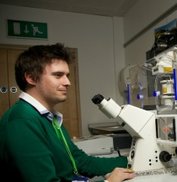
Dr Lori Borgal
Royal Society Newton Fellow
[email protected]
I completed my PhD in Pharmacology & Experimental Therapeutics at the University of Cologne in Germany, and my MSc in Anatomy & Neurobiology at Dalhousie University in Canada. I currently hold a Royal Society Newton Fellowship and am studying the role of the microcephaly- and cancer-associated protein asp/ASPM in forming the mitotic spindle in different cell types. Lori is now an Assistant Professor at Mount Saint Vincent University in Canada.
Royal Society Newton Fellow
[email protected]
I completed my PhD in Pharmacology & Experimental Therapeutics at the University of Cologne in Germany, and my MSc in Anatomy & Neurobiology at Dalhousie University in Canada. I currently hold a Royal Society Newton Fellowship and am studying the role of the microcephaly- and cancer-associated protein asp/ASPM in forming the mitotic spindle in different cell types. Lori is now an Assistant Professor at Mount Saint Vincent University in Canada.

Alison Jackson
MRes Student
As an undergraduate and now as an MRes student in the Wakefield lab, my research has primarily involved identifying the mitotic localisation and protein interactions of several proteins in Drosophila. This is done through live fluorescence microscopy and immunoprecipitation and mass spectrometry of GFP-tagged proteins of interest. The protein interaction data can then be used to build a protein-protein interaction network in Drosophila.
MRes Student
As an undergraduate and now as an MRes student in the Wakefield lab, my research has primarily involved identifying the mitotic localisation and protein interactions of several proteins in Drosophila. This is done through live fluorescence microscopy and immunoprecipitation and mass spectrometry of GFP-tagged proteins of interest. The protein interaction data can then be used to build a protein-protein interaction network in Drosophila.

Dr Jack Chen
Postdoc
ajackweichuchen@gmail.com
During my time in the Wakefield Lab (from 2010-2016) I worked primarily on the structure and function of the Agumin complex. Augmin, consisting of 8 different proteins, is responsible for regulating microtubule generation around pre-existing microtubules. One of the main aspects of my research was the cross-linking mass spectrometry (CL-MS) of Drosophila Augmin, in collaboration with Juri Rappsilber's lab, in Edinburgh. Before joining the Wakefield lab, I did my masters with Dr. Graham Dellaire at Dalhousie University, Halifax, Canada. My research project was on the regulation of promyelocytic leukemia protein phosphorylation, and its interaction with other proteins, in the DNA damage response pathway. My special skills include being quasi-ambidextrous and able to fence with either hands, and being a pundit at cracking eggcellent jokes. Jack worked with Anne Straub in Warwick 2017-2020 and is now a scientist at Oxford Biomedica.
Postdoc
ajackweichuchen@gmail.com
During my time in the Wakefield Lab (from 2010-2016) I worked primarily on the structure and function of the Agumin complex. Augmin, consisting of 8 different proteins, is responsible for regulating microtubule generation around pre-existing microtubules. One of the main aspects of my research was the cross-linking mass spectrometry (CL-MS) of Drosophila Augmin, in collaboration with Juri Rappsilber's lab, in Edinburgh. Before joining the Wakefield lab, I did my masters with Dr. Graham Dellaire at Dalhousie University, Halifax, Canada. My research project was on the regulation of promyelocytic leukemia protein phosphorylation, and its interaction with other proteins, in the DNA damage response pathway. My special skills include being quasi-ambidextrous and able to fence with either hands, and being a pundit at cracking eggcellent jokes. Jack worked with Anne Straub in Warwick 2017-2020 and is now a scientist at Oxford Biomedica.

Dr Pete Jones
Postdoc between 2010 and 2013.
The chromosomal passenger complex (CPC) is a key regulator of cell division and has crucial roles throughout the cell cycle. This complex consists of the Aurora B kinase and three other subunits – Incenp, Borealin and Survivin – which are essential for its highly dynamic localisation (see movie) and activity. The CPC regulates various stages of cell division – spindle assembly, chromosome alignment, correction of microtubule-kinetochore attachment errors, central spindle and ultimately cytokinesis. Pete used proteomic approaches to attempt to identify novel Aurora B substrates and interactors of the complex. Pete is now working in the Department of Cardiovascular Sciences at the University of Leicester.
Postdoc between 2010 and 2013.
The chromosomal passenger complex (CPC) is a key regulator of cell division and has crucial roles throughout the cell cycle. This complex consists of the Aurora B kinase and three other subunits – Incenp, Borealin and Survivin – which are essential for its highly dynamic localisation (see movie) and activity. The CPC regulates various stages of cell division – spindle assembly, chromosome alignment, correction of microtubule-kinetochore attachment errors, central spindle and ultimately cytokinesis. Pete used proteomic approaches to attempt to identify novel Aurora B substrates and interactors of the complex. Pete is now working in the Department of Cardiovascular Sciences at the University of Leicester.

Dan Hayward
PhD student in the lab between 2010-2013.
His research focused on the multiple apparatus that contribute to the building of the mitotic spindle, and the pathways and molecules that underpin these mechanisms. His model system is the single celled, multi-nuclei Drosophila early syncytial embryo, enabling him to use high resolution confocal microscopy to obtain 4-dimensional images of mitotic spindles forming in vivo. This system also allows the use of biochemistry, proteomics, genetics and interfering antibody injection. His work was recently published in Developmental Cell (Hayward et al., 2014) and in Communicative and Integrative Biology (Hayward and Wakefield, 2014). Dan is currently a post-doc with Ulli Gruneberg at the Dunn School of Pathology, University of Oxford, where he is looking at the role of post-translational modifications on protein function during spindle formation.
PhD student in the lab between 2010-2013.
His research focused on the multiple apparatus that contribute to the building of the mitotic spindle, and the pathways and molecules that underpin these mechanisms. His model system is the single celled, multi-nuclei Drosophila early syncytial embryo, enabling him to use high resolution confocal microscopy to obtain 4-dimensional images of mitotic spindles forming in vivo. This system also allows the use of biochemistry, proteomics, genetics and interfering antibody injection. His work was recently published in Developmental Cell (Hayward et al., 2014) and in Communicative and Integrative Biology (Hayward and Wakefield, 2014). Dan is currently a post-doc with Ulli Gruneberg at the Dunn School of Pathology, University of Oxford, where he is looking at the role of post-translational modifications on protein function during spindle formation.

Faisal Khan
PhD student in the lab, jointly supervised by Charlotte Deane's Bioinformatics lab in Oxford, between 2009-2013.
In my inter-disciplinary project, we created an extended Protein-protein interaction (PPI) network, or interactome, for mitotic microtubule-associated proteins (MAPs) in Drosophila. Each protein, or node, in this network was annotated with different experimental and bioinformatics data, and then using a statistical model, we scored each protein based on the predicted likelihood of their involvement in mitosis. By combining and using multiple types of available biological data, our interactome not only predicts the likelihood of a mitotic role for our putative MAPs but also unravels the inter-relationship of different proteins and their functions. This gives us an integrated view of the process and guides our in vivo study of novel mitotic proteins. I am now chasing some very interesting candidate proteins (back in the wetlab) using an array of methods from biochemistry, cell biology and genetics. Faisal is now the Director of the Institute of Integrative Biosciences at CECOS University in Pakistan.
PhD student in the lab, jointly supervised by Charlotte Deane's Bioinformatics lab in Oxford, between 2009-2013.
In my inter-disciplinary project, we created an extended Protein-protein interaction (PPI) network, or interactome, for mitotic microtubule-associated proteins (MAPs) in Drosophila. Each protein, or node, in this network was annotated with different experimental and bioinformatics data, and then using a statistical model, we scored each protein based on the predicted likelihood of their involvement in mitosis. By combining and using multiple types of available biological data, our interactome not only predicts the likelihood of a mitotic role for our putative MAPs but also unravels the inter-relationship of different proteins and their functions. This gives us an integrated view of the process and guides our in vivo study of novel mitotic proteins. I am now chasing some very interesting candidate proteins (back in the wetlab) using an array of methods from biochemistry, cell biology and genetics. Faisal is now the Director of the Institute of Integrative Biosciences at CECOS University in Pakistan.

Lizzy Anderson
MRes Student
During mitosis various proteins interact with microtubules as MAPs to aid the process. My MRes project investigated the possibility of a Drosophila protein called stem loop-binding protein (Slbp) as being a MAP during mitosis. Slbp has previously been characterised to have a role in histone pre-mRNA processing, however, I was able to visualise a GFP-tagged version of Slbp in the region of the microtubules during mitosis. Further to this, mass spectrometry analysis identified a large number of specific interacting proteins, with various functions, suggesting that Slbp may be playing a larger role. When I am not in the lab I am a keen baker and runner (to counter-act the baking!), and I enjoy music and doing open-mic nights around Exeter.
MRes Student
During mitosis various proteins interact with microtubules as MAPs to aid the process. My MRes project investigated the possibility of a Drosophila protein called stem loop-binding protein (Slbp) as being a MAP during mitosis. Slbp has previously been characterised to have a role in histone pre-mRNA processing, however, I was able to visualise a GFP-tagged version of Slbp in the region of the microtubules during mitosis. Further to this, mass spectrometry analysis identified a large number of specific interacting proteins, with various functions, suggesting that Slbp may be playing a larger role. When I am not in the lab I am a keen baker and runner (to counter-act the baking!), and I enjoy music and doing open-mic nights around Exeter.
